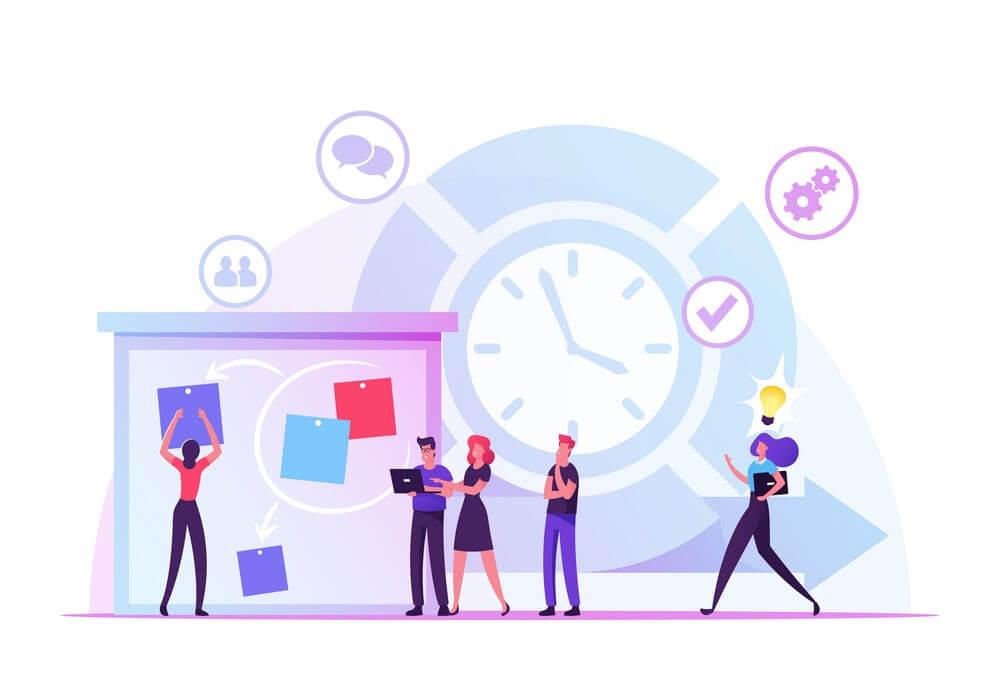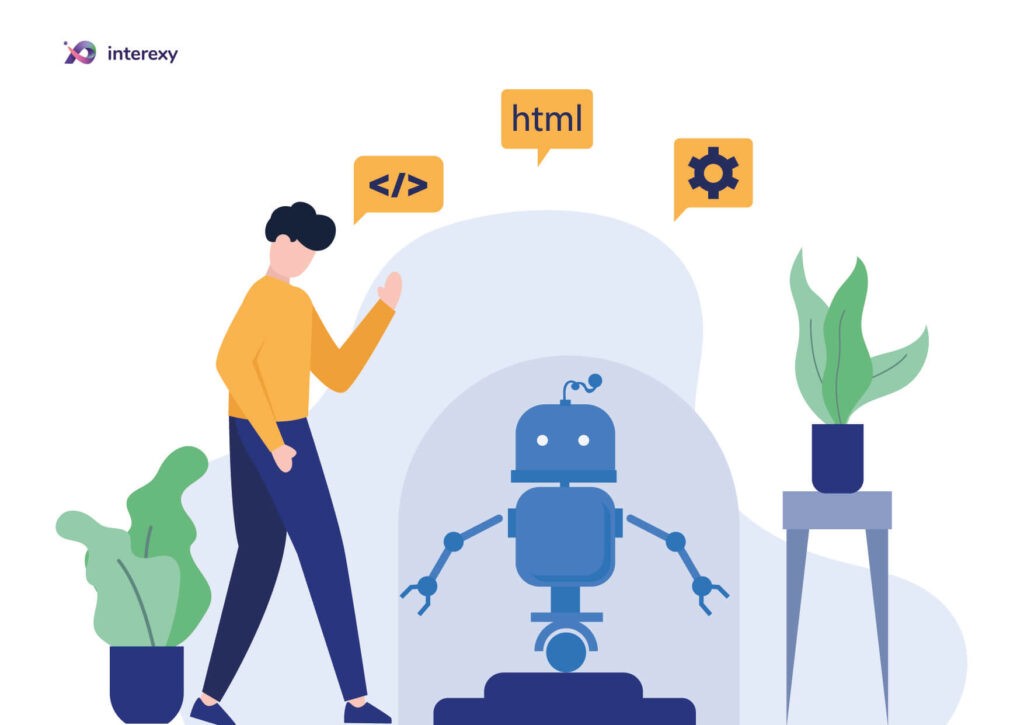December 16, 2021
Agile Web Development Processes: Comprehensive Overview by Interexy
Table of content
Although some people believe that Agile web development is a unique methodology, in reality, it is an umbrella for quite a broad category of methods that rely on the principles outlined in the Manifesto for Agile Software Development. This was developed by a team of experts in 2001. What is more, well-known Scrum and XP are also related to Agile even though they were used before the manifesto was compiled.
To put it simply, Agile represents a web development process that combines adaptive planning and partnering between self-organizing, cross-functional teams. The primary goal was to provide higher flexibility and offer rapid and continuous improvement of various software products. In addition, the method provides earlier delivery since it boosts streamlining projects by reducing labor-consuming tasks.Since it has been around for approximately two decades, most of the crucial concepts in this methodology seem intuitive for developers. However, this methodology was crafted to become radically different from older ways of performing regular processes. According to Betanews.com, 97 percent of software companies now apply Agile methods over Waterflow web development. So it can be safely said that the technique is gaining popularity and is going to become a norm in the programming community in upcoming years.
What are the most popular web development processes?
1. Waterfall
Designed in 1970, Waterflow is now listed as the most traditional choice for software development. Even though it is sometimes called outdated, many companies still apply it to better learn the history and structure. The waterfall method needs plenty of structure and documentation because it compromises into self-contained steps. The steps are relatively stiff, usually following the sequence: figure out the project’s requirements and create scope, analyze listed requirements, design, develop, test, deploy and then maintain.
Waterflow lacks flexibility, as the whole process depends on what a client and the crew applied at the very first stages. Therefore, if any changes have to be made, the project requires a full restart.

2. Feature-Driven Development
Also known as FDD, this refers to an iterative and incremental approach that was sourced from the Agile methodology. The methodology is used as one way to implement it into the software. Similar to the first one, FDD is quite outdated, with a focus on providing working software frequently with a client-centric approach.
3. Agile
The methodology was started to reduce all issues that appear with other methodologies. This is a highly flexible approach to adapt to changes to produce the final product faster without losing quality.
It focuses on people rather than on technologies, creating a functional workflow that can easily adapt to any changes and keep close contact with a client through the whole process. It also follows a goal of presenting working software rather than specification and documentation at early stages.
Unlike other techniques, Agile is prepared to handle the complexity involved in various projects. When using this approach, the team doesn’t follow a well-detailed plan. The team develops the software in short sprints or iterations, where each requires a defined duration and list of deliverables, resulting in a fruitful collaboration between all departments.
4. Scrum
Another approach to implementing Agile flexibility is Scrum web development that shares a philosophy that teams should work in unison every day heavily. Using Scrum, developers produce software following an iterative approach where teams represent front and center. They have to be highly organized, experienced, and disciplined experts working on small blocks to achieve success.
The lifecycle of agile web development processes
1. Learn the client’s requirements
Every project starts from learning and understanding the information provided by the client. Some come with the concept, some only have an idea with a prospective target audience. However, it is the initial and essential part of success. Once everything is identified, prioritized, and the needed resources are selected, the company agrees on the resources needed for the further product.

3. Sprint Planning
The next step is creating a sprint which is a period during which the stage of the process is completed and ready for the client’s review. According to the latest study, approximately 83% perform sprint planning in advance of each Sprint. This helps develop it targeted based on the target audience, where the team firstly figures out the duration of each Sprint. Therefore, the client’s feedback is received regularly, so the team can resolve bugs and adapt changes on time.
4. Designing the product
This is the most vital part where the teams design the final website. The task is delivered to the respective developers and UX/UI designers. Within the stage, a client and the BA track the tasks in the form of a board where they move “cards” from the “To Do,” “In Progress,” and “Ready” list.
The fundamentals of the agile technique include speed and scale. The first one means the duration of time required to fix the user’s problems. Faster feedback and a more detailed list of issues help to produce a more efficient product
5. Testing
Although it is almost the last step, the testing checks content and navigation right from the beginning. However, here developers perform the small delivery sets to the client, who gives rapid feedback ensuring better functionality and higher speed. The web product is tested simultaneously, so the results are also presented immediately to the client.
6. Final feedback and next working set
When the team receives final feedback, the teams discuss the results. Here they try to find out how the product can be improved and what further steps should be taken, which represent a background applied to the next working set.

Benefits Of Choosing Agile Methodology
Functional Stakeholder Engagement
This way gives numerous opportunities for stakeholders engagement during all steps of the Sprint. Through client involvement at every step of the project, success is almost guaranteed and also ensures high efficiency of collaboration between the team and a client. This not only offers a greater functionality of two parties but also boosts the client’s loyalty and gives confidence in the chosen partner.
Fast and Predictable Project Delivery
Since this approach uses time-boxed schedule Sprints from 1 to 4 weeks, the project delivery is early and can be predicted at the very beginning. Even new features can also be delivered frequently, giving a high level of predictability and transparency.
No Hidden Costs and Understandable Schedule
Each Sprint comes with a fixed duration, so the cost can be predicted early while also providing a limit to the working time that will be done in the fixed-schedule time box. This helps clients be ready to price provided by the partner at the first stages and not afraid about hidden costs, easing the decision making regarding the priority of features.
Easy Changes
Even though the process focuses on delivering an agreed project, there is always a space to make easy changes. Adding new or changed backlog things will be planned for the next working set, allowing clients to bring new ideas to reality within a few weeks.
Targeted Business Value
Because the methodology helps prioritize features, the crew understands the most required items and value to the client’s business, doing the final project packed with only necessary features that ensure targeted business value.

Improves Product Quality
By breaking down the process into manageable and tracking blocks, the project crew works on quality, testing, and efficient collaboration. In addition, by offering frequent builds and performing rigorous testing during each Sprint, the product quality is improved by checking and fixing defects almost immediately and predicting mismatches in advance.
Our Web Development Services
Interexy is an experienced company that produces unmatched quality projects based on every client and industry’s requirements. We have solid experience in app and web development services with experts ready to realise any idea.
Our web services include websites, portals, custom web solutions for enterprises, SaaS, products for e-commerce, custom CMS as well as detailed UX/Ui design. Our life cycle always comprises planning, designing, developing, testing, and launching the final product. We are also big fans of Agile and other methodologies that our clients prefer, providing a rich choice.
We ensure transparency and clients involvement during every step to provide unmatched quality, bugs-free solutions and success in the market within a short time and competitive price. Consult our experts, and let’s learn more about what we do!
The bottom line
Even though there are numerous companies and methods to perform web solutions, only a few today can really provide great results without sacrificing quality, time, and money. We, at Interexy, always show clients our in-depth expertise and strive to give everyone peace of mind regardless of the complexity and sphere. This article has been developed by our experts to bring you a better understanding of the fascinating way to enter the web industry and learn how it can benefit your business. Let’s get in touch for more details.
FAQs
What is Scrum in Web Development?
Scrum refers to an agile methodology that is widely used in Software development based on iterative and incremental techniques. The main objective of Scrum is to produce high-quality solutions satisfying clients’ needs, overcome expectations and meet’s industry’s requirements working in an environment of open transparency in close collaboration, collective responsibility, and continuous progress.
What are agile techniques and tools?
There are many tools and techniques applied to the method, but the most prominent are V-shape SDLC, Iterative SDLS, Spiral SDLC, Waterfall SDLC. They all are highly efficient and practice proven, allowing companies to adapt to any changes and industry’s needs.
What is a Waterfall Web Development Methodology?
The waterfall method means moving from one step to another, one at a time. This means the team does not return to previous stages until all other phases are done. It is like building a house, where each layer is constructed and then starts another when the former is developed accurately and tested.
How to choose a partner for web solutions?
Once you have a concept or an idea, you need to ensure the chosen partner has a solid background and experience in web services. Reliable companies will provide detailed information on the website, showing case studies, landing pages with well-thought-out structure, offering coding standards and UX/UI design. Once it is reviewed by your team, move to a personal conversation with a prospective partner to ask every question. Here you can find out prices, learn what processes the company uses and get a better understanding of its team.















